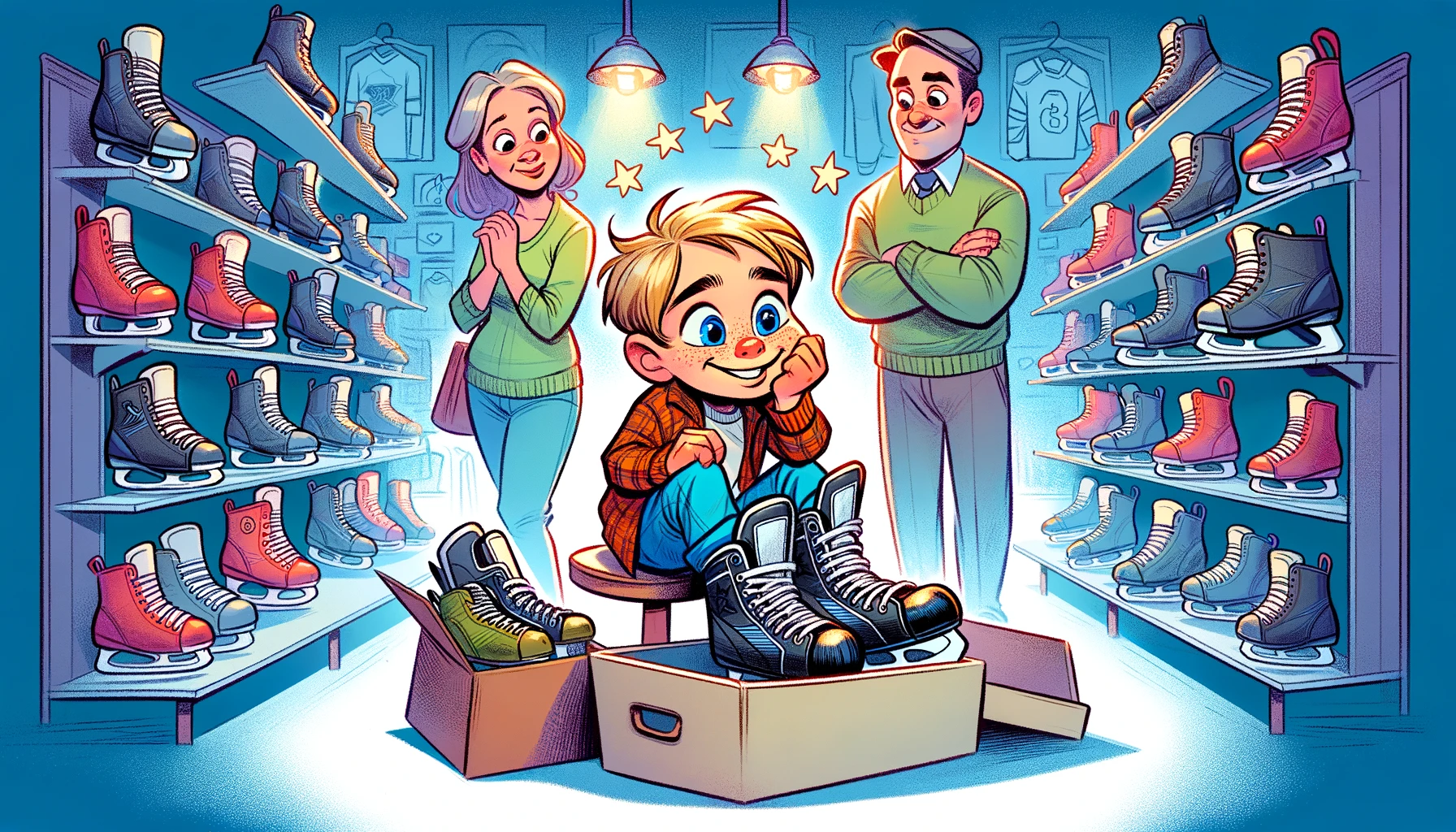If you’re on the hunt for the perfect pair of ice skates for your little ones, you’ve landed in the right spot. Buying kids ice skates for kids can seem daunting when you’re not sure what you’re looking for, but with the right advice, you’ll be gliding through this process in no time. Let’s lace up and dive into everything you need to know about sizing and purchasing the best ice skates for your kids.
I’ve played hockey since I was 5 and fitted more than a few pairs over the years. Our 7-year-old has been playing for a couple of years now and our 4 and 3-year-olds just got their first skates this year for their skating lessons. The difficulty of finding skates can be made even worse when you’re dealing with kids at 4 and 3 because they can’t really describe what they are feeling either.
But not to worry, by the end of this post, you’ll be confident heading to your local sporting goods store and grabbing your kids a pair of skates.
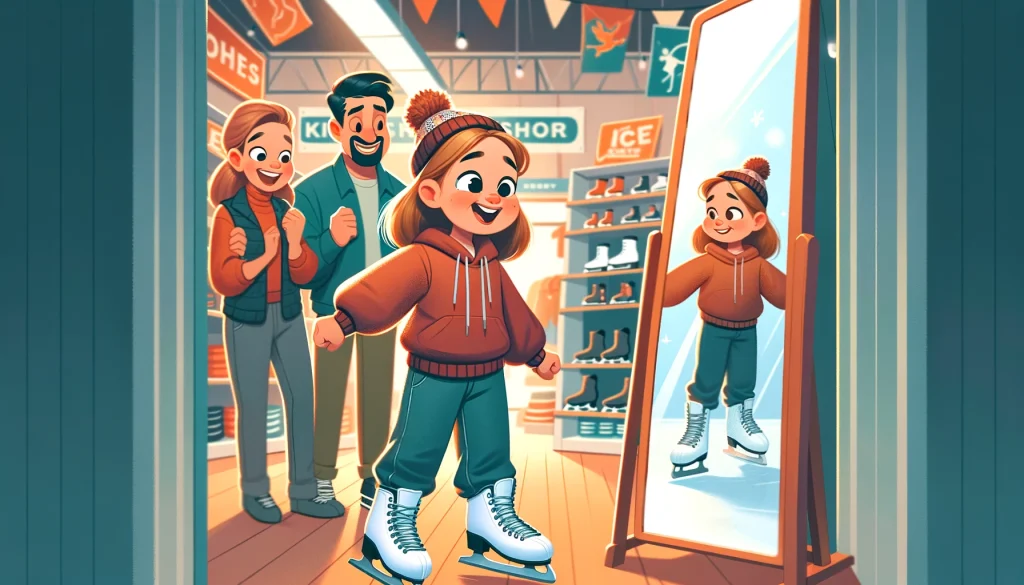
Sizing Guide for Kids’ Ice Skates
Getting the right size in kids’ ice skates is like hitting the sweet spot in parenting—challenging but oh-so rewarding when you get it right. A proper fit ensures your child’s comfort, performance, and, most importantly, safety on the ice. Let’s walk through how to measure those tiny feet at home and ensure a fit that’s just right.
Step-by-step Guide
- Check their shoe size: Hockey skates will fit about 1-1.5 sizes smaller than typical shoe sizing. This will give you a good starting point to work from.
- Add growth room: Kids grow quickly and you don’t want to be buying new skates multiple times per year. But you also don’t want your kids feeling like they’ve got clown feet and getting blisters from skating. Just like buying street shoes, adding a half-size for growth is a happy medium between the two.
- Try On The Skates: Have your son or daughter try on the skates but don’t tie them up just yet. Hold the toe (front) of the skate and have your child push their foot toward the front as far as they can. Then have them lean forward slightly so you can see down to their heel. You want to be able to fit a finger down between their heel and the back of the skates similar to how you would press on the toe of a street shoe.
- Tie Up The Skates: Tie them up nice and snug, starting from the bottom lace and working towards the top. There shouldn’t be any pinching on their foot.
- Check For Fit Around The Ankles: If your kids aren’t used to skating their ankles won’t be strong enough to hold the skates straight and that’s okay – but you don’t want to see the ankle moving around within the boot.
- Have them walk around: Just like trying on a new pair of shoes, have them walk around and see how they feel. Ice skates are very different from shoes and are much firmer but otherwise, they shouldn’t have pinch points.
Common Mistakes to Avoid
- Not Accounting for Growth: Allow for about 0.5 cm (or 1/4 inch) of growth room, but no more. Too much space can cause blisters and affect skating technique by having too much of an oversized
- Measuring With The Socks They’ll Play In: Measure your child’s feet with the socks they’ll wear while skating for the most accurate size. I never liked thick wool socks when playing or your feet get too hot once you start playing and too thin socks will mean wearing on the skin – particularly at the ankles.
- Ignoring Width: Some children have wider or narrower feet. Pay attention to the width of the brands, each brand will fit differently, just like shoe brands.
How Snug is Too Snug? Finding the Perfect Balance
The fit of the skate should be snug but not tight. You’re aiming for a “hug” around the foot—enough to support but not so tight that it cuts off circulation or causes discomfort. A good rule of thumb is to allow your child to wiggle their toes slightly, but their heel should not lift inside the boot.
The Role of Socks in Ice Skate Sizing
Socks can play a surprisingly big role in the fitting of ice skates. Thick socks can add unnecessary bulk or very hot and sweaty feet which leads to a tighter fit too. Too-thin socks may not provide enough cushioning and can cause chaffing at the ankles. Opt for a long medium-thick, moisture-wicking sock designed for the right balance between comfort and fit.
Remember, the right fit in kids’ ice skates can make all the difference between a child who loves to skate and one who’s counting down the minutes until they can take the skates off. Take your time with the measuring process, consider the type of socks they’ll wear, and don’t be afraid to ask for advice or exchange sizes if the fit isn’t just right. After all, every step, glide, and twirl on the ice begins with a well-fitted skate.
Understanding the Basics of Kids’ Iceg Skates
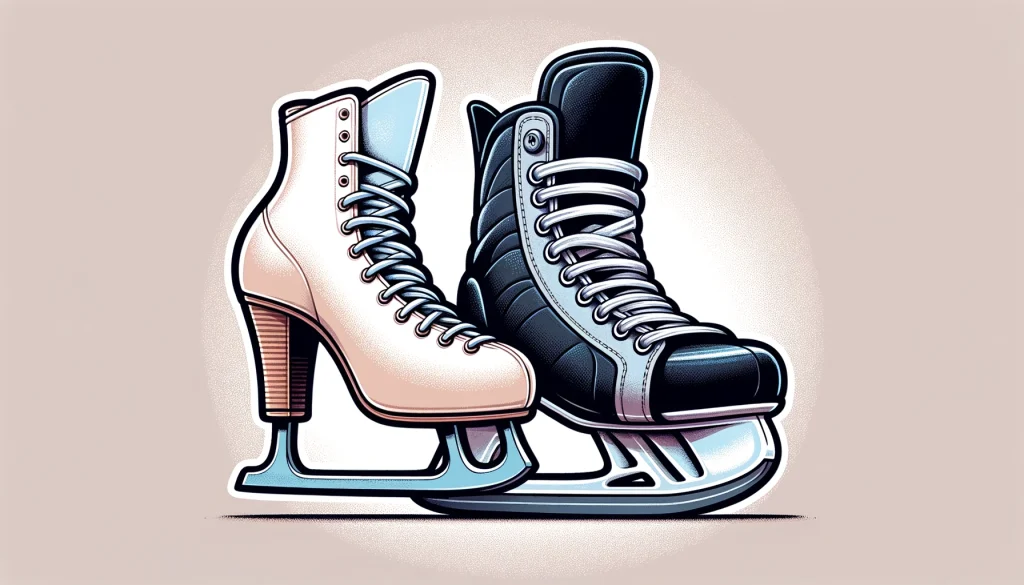
When it comes to picking out ice skates for your kids, knowing where to start can feel a bit like stepping onto the ice for the first time—exciting but a tad overwhelming. But worry not! We’re here to break down the basics, making your decision as smooth as freshly Zamboni-ed ice.
The Different Types of Ice Skates
Figure Skates vs. Hockey Skates: What’s Best for Your Child?
First off, let’s tackle the two main types of skates you’ll encounter: figure skates and hockey skates. The choice between the two boils down to what kind of skating experience your child is after.
Figure skates come with a set of toe picks on the front of the blade, which are crucial for performing jumps and other figure skating maneuvers. They’re designed to offer more support around the ankles and have longer, straighter blades for graceful gliding and precision.
Hockey skates, on the other hand, are built for speed and agility. They have a rounded blade, no toe picks, and offer a snugger fit. This design helps with quick turns and stops, making them the go-to for kids who dream of zipping around the rink or aspiring to be the next hockey superstar.
So, which is best for your child? If they’re drawn to the artistic side of skating or want to try their hand at jumps and spins, figure skates are the way to go. But if they’re all about that fast-paced action, hockey skates will be their best ally on the ice.
Adjustable Skates: A Cost-Effective Choice for Fast-Growing Feet
We all know how quickly kids grow, and it can feel like you’re buying new skates every season. That’s where adjustable skates come in handy.
Adjustable skates can be expanded to accommodate growing feet, ensuring a couple of seasons’ worth of use. This not only saves you money in the long run but also spares you the hassle of skate-shopping every year. Plus, they’re available in both figure and hockey skate styles, so you’re not limited in choice.
While they might cost a bit more upfront, adjustable skates may be worth the investment, especially for kids who are still growing or those who are just starting out and might not yet be sure which type of skating they prefer.
Choosing the right ice skates for your child doesn’t have to be a tricky business. Whether you opt for figure skates, hockey skates, or versatile adjustable ones, the key is finding a pair that supports your child’s skating ambitions and fits them comfortably. And remember, the best skates are the ones that get your kids excited to hit the ice and enjoy every glide, spin, and goal they achieve.
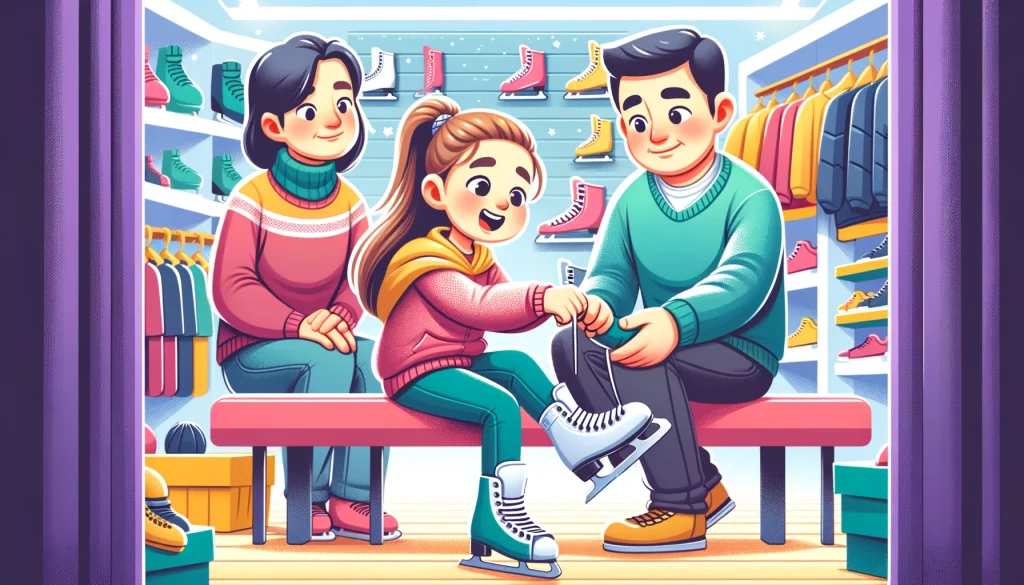
Where to Buy Kids’ Ice Skates
Whether you’re leaning towards the personal touch of local shops or the convenience of online shopping, we’ve got the scoop to help you navigate your options.
Local vs. Online Shopping
Local Shopping:
Pros:
- Try Before You Buy: The biggest perk is that your child can try on different skates to find the perfect fit.
- Expert Advice: Staff often have a wealth of knowledge and can offer personalized recommendations.
- Instant Gratification: Walk in, pick out skates, and walk out; no waiting required.
Cons:
- Limited Selection: Smaller shops may not have every size or brand.
- Potentially Higher Prices: Brick-and-mortar stores often have higher overhead, which can translate to higher prices.
Online Shopping:
Pros:
- Wider Selection: Access to a vast array of brands and sizes at your fingertips.
- Convenience: Shop anytime, anywhere, without leaving your home.
- Price Comparisons: Easy to shop around for the best deals.
Cons:
- Sizing Uncertainties: Without trying them on first, there’s a risk of getting the wrong size.
- Returns Hassle: If they don’t fit, returning products can be a chore.
How to Ensure a Good Fit When Buying Online
- Use the Brand’s Sizing Chart: Measure your child’s feet and compare with the brand’s sizing guide.
- Read Customer Reviews: Other buyers can offer valuable insights into how true to size the skates are.
- Look for Adjustable Options: As mentioned, adjustable skates can offer a bit more flexibility with sizing.
What to Look for in a Retailer: Return Policies and Customer Service
Whether you’re shopping online or in person, the retailer’s return policy is crucial. Look for stores that offer hassle-free returns, allowing you to exchange sizes if needed. Excellent customer service, whether it’s in helping choose the right skate or handling returns, can make the buying process much smoother and more enjoyable.
Choosing where to buy your kids’ ice skates comes down to balancing convenience, selection, and the ability to find the right fit. Whether you decide to support a local store or take advantage of the vast selection online, ensure you’re purchasing from a retailer that puts customer satisfaction at the forefront. With the right skates in hand, your child is set for fun, exercise, and maybe even a new passion on the ice!
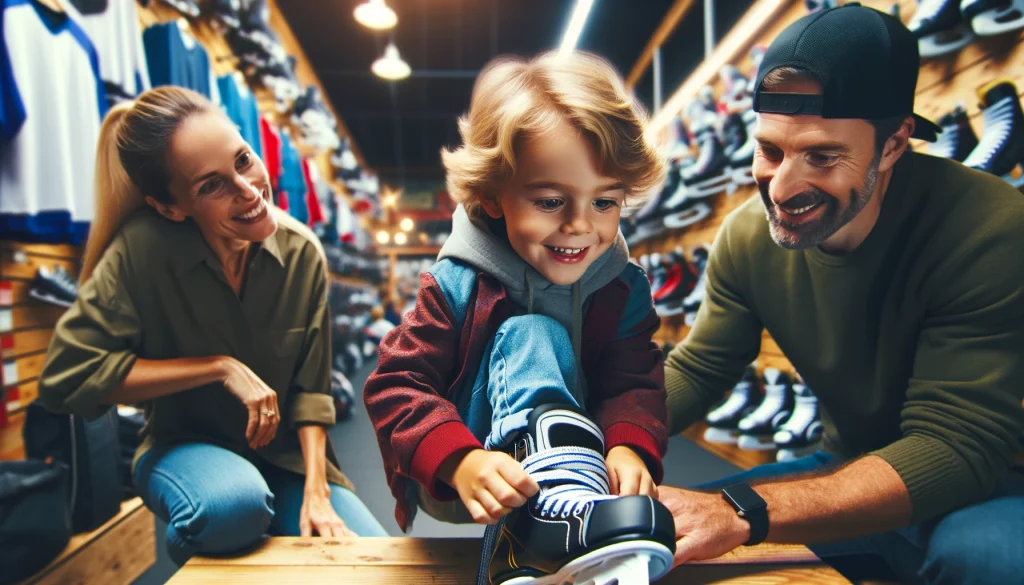
Caring for Ice Skates: Tips and Tricks
Just like any cherished item in our kids’ sporting arsenal, ice skates require a little TLC to stay in tip-top shape. Think of them as trusty companions on your child’s icy adventures—they’ll perform better and last longer with the right care. Let’s dive into some essential maintenance tips and know-how on recognizing when it’s time for an upgrade.
Keeping Blades Sharp and Rust-Free
- Blade Sharpening: Regular sharpening is crucial for optimal performance. How often? It depends on how frequently the skates are used, but a good rule of thumb is to sharpen them after every 20 hours of ice time. Sharp blades ensure better grip and more precise movements on the ice.
- Preventing Rust: Moisture is the enemy here. Always dry the blades thoroughly with a soft cloth after each use. Don’t forget the nooks and crannies where ice and water love to linger. To go the extra mile, consider using blade covers made of absorbent material when the skates are not in use.
Proper Storage Practices to Extend the Life of Ice Skates
- Breathable Storage: When not in use, it’s best to store skates in a dry, well-ventilated area. Avoid plastic bags which can trap moisture and encourage rust. Instead, opt for breathable skate bags.
- Support the Boot: To help maintain the skate’s shape, you can insert a soft cloth or paper inside the boots to absorb any residual moisture and keep the interior fresh.
- Take off skate guards: Skate guards can be great for preventing the blades from cutting gear, jerseys or socks in the hockey bag but leaving them on wet skates will lead to rust. So once you get home, air out the gear and remove the skate guards to let them dry.
When to Upgrade
Signs It’s Time for a New Pair
- Outgrown Skates: The most obvious sign is when they no longer fit. Remember, proper fit is essential for safety and performance.
- Wear and Tear: Inspect the boots and blades regularly. If you notice significant wear, such as cracks in the boot or severe nicks in the blade that can’t be smoothed out, it might be time for new skates. If it’s just the fabric toe that’s been torn up you can also buy Toe Pro which provides a new hard toe cover once it dries.
How to Transition to More Advanced Skates as Your Child Improves
- Gradual Transition: Allow your child some time to adjust to their new skates. Advanced skates often offer less forgiveness than beginner models, so a period of adjustment is normal.
- Fit Over Features: While advanced features are enticing, the right fit should always be your top priority. Ensure the new pair supports your child’s feet comfortably and securely. I played high-level hockey for years growing up, never spending more than $150 on a pair of skates. Having more expensive skates won’t make your son or daughter a better hockey player.
Caring for and upgrading ice skates are crucial steps in supporting your child’s skating journey. With proper maintenance, you can ensure their skates are always ready for action, and by recognizing the right time to upgrade, you help pave the way for their continued growth and enjoyment in the sport. Here’s to many more happy and successful days on the ice!
Find a great gift idea for the hockey dad in your life
FAQs on Buying Kids Ice Skates
Navigating the world of kids’ ice skates comes with its fair share of questions. From figuring out the right time for a new pair to choosing the correct size and ensuring safety on the ice, it’s all part of the parenting puzzle. Let’s tackle some of the most common questions to help you make informed decisions for your young skater.
How Often Should I Replace My Child’s Ice Skates?
The frequency of replacing ice skates largely depends on how quickly your child’s feet grow and how intensively they use the skates. A telltale sign it’s time for a new pair is when they start complaining of discomfort, or you notice their toes are at the very end of the boot. For kids in the midst of growth spurts, you might find yourself shopping for skates once a season or once a year. Keeping an eye on their foot size and any visible wear and tear on the skates will guide you in making the right call.
Can I Buy Larger Skates for My Child to Grow Into?
While it might be tempting to buy skates a size or two larger to extend their usage life, this isn’t the best strategy for ice skates. Too much room can lead to a lack of support and control, increasing the risk of falls and foot injuries. Instead, look for skates that fit well now, with just enough room to wiggle the toes. Adjustable skates are a fantastic option, offering a better fit over a range of sizes as your child grows.
What Safety Gear is Recommended for Young Skaters?
Safety on the ice is paramount, especially for beginners who are still finding their balance. Here’s the essential safety gear for young skaters:
- Helmet: A must-have to protect against head injuries. Look for a helmet specifically designed for ice skating or a multi-sport helmet that includes ice skating as a recommended activity.
- Knee and Elbow Pads: These can help cushion falls and prevent scrapes and bruises.
- Wrist Guards: Wrist injuries are common in ice skating, so wrist guards are a good idea, particularly for beginners.
- Gloves: Not only do they keep hands warm, but gloves also protect the hands from cuts and bruises during falls.
Equipping your child with the right size ice skates and essential safety gear not only enhances their skating experience but also contributes to their confidence and progress on the ice. Remember, the goal is to ensure they enjoy every moment, safely and comfortably. If you have any more questions or need advice, don’t hesitate to reach out to coaches or experienced skate shop staff—they’re a wealth of information and always happy to help fellow ice skating enthusiasts!
Wrapping Up How To Buy Ice Skates For Kids
Finding the perfect ice skates for your kids is an exciting part of their skating adventure. From understanding the basics and sizing to choosing where to buy and knowing when to upgrade, we’ve covered the essential steps to ensure your little ones have the best support as they glide, twirl, and speed across the ice. Remember, the key to a great skating experience lies not just in the skates themselves but also in proper care, maintenance, and safety practices. With these tips and insights, you’re all set to make informed decisions, fostering a love for ice skating in your children that could last a lifetime.
Happy skating!

